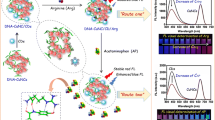Abstract
CdS nanoparticles linked through a duplex DNA to a Au electrode do not lead to a noticeable photocurrent upon their illumination in the presence of triethanolamine, TEOA, 20 mM, pH = 7.2. The intercalation of doxorubicin into the duplex DNA stimulates, however, the generation of a photocurrent. This is attributed to the trapping of photoexcited conduction-band electrons by the intercalator units that facilitates, by a hopping mechanism, the electron transport to the electrode. The oxidation of TEOA by valence band holes allows the formation of a steady state photocurrent. This basic phenomenon is used to probe the operation of a DNA-based machine through the assembly of CdS nanoparticles on a Au electrode. The machine includes a nucleic acid “track”, (1), that binds a primer, (2), through hybridization to a predefined domain. In the presence of polymerase, the nucleotide mixture, dNTPs, and the nicking enzyme, the autonomous replication, nicking and displacement of the “waste product”, (3), are activated. The “waste product” bridges the (4)-functionalized CdS nanoparticles and the nucleic acid (5)-functionalized Au electrode, resulting in the assembly of the nanoparticles on the electrode. The intercalation of doxorubicin into the DNA-CdS nanostructures results in the generation of photocurrents upon illumination in the presence of TEOA, pH = 7.2. The photocurrents are controlled by the time intervals used to operate the DNA machine.
Similar content being viewed by others
References
A. P. Alivisatos, Semiconductor clusters, nanocrystals, and quantum dots, Science, 1996, 271, 933–937
H. Weller, Colloidal semiconductor Q-particles: Chemistry in the transition region between solid state and molecules, Angew. Chem., Int. Ed. Engl., 1993, 32, 41–53.
A. Henglein, Small particle research—Physicochemical properties of extremely small colloidal metal and semiconductor particles, Chem. Rev., 1989, 89, 1861–1873
P. V. Kamat, Photochemistry on nonreactive and reactive (semiconductor) surfaces, Chem. Rev., 1993, 93, 267–300
A. Hagfeldt and M. Gratzel, Light induced redox reactions in nanocrystalline systems, Chem. Rev., 1995, 95, 49–68.
B. O. Dabbousi, J. Rodriguez Viejo, F. V. Mikulec, J. R. Heine, H. Mattoussi, R. Ober, K. F. Jensen and M. G. Bawendi, (CdSe)ZnS core-shell quantum dots: Synthesis and characterization of a size series of highly luminescent nanocrystallites, J. Phys. Chem. B, 1997, 101, 9463–9475.
W. C. W. Chan and S. M. Nie, Quantum dot bioconjugates for ultrasensitive nonisotopic detection, Science, 1998, 281, 2016–2018.
V. Maurel, M. Laferrière, P. Billone, R. Godin and J. C. Scaiano, Free radical sensor based on CdSe quantum dots with added-amino-2,2,6,6-tetra-methyl-piperidine-oxide functionality, J. Phys. Chem. B, 2006, 110, 16353–16358
Y. Lai, Y. Yu, P. Zhong, J. Z. Wu, Z. Y. Long and C. S. Liang, Development of novel quantum dots as fluorescent sensors for application in highly sensitive spectrofluorimetric determination of Cu2+, Anal. Lett., 2006, 39, 1201–1209.
I. L. Medintz, H. T. Uyeda, E. R. Goldman and H. Mattoussi, Quantum dot bioconjugates for imaging, labelling and sensing, Nat. Mater., 2005, 4, 435–446
E. Katz and I. Willner, Integrated nanoparticle-biomolecule hybrid systems: Synthesis, properties, and applications, Angew. Chem., Int. Ed., 2004, 43, 6042–6108.
Z. Y. Tang, Y. Wang and N. A. Kotov, Semiconductor nanoparticles on solid substrates: Film structure, intermolecular interactions, and polyelectrolyte effects, Langmuir, 2002, 18, 7035–7040.
J. P. Xu, Y. Weizmann, N. Krikhely, R. Baron and I. Willner, Layered H-bonded nucleotide-functionalized CdS nanoparticles for photoelectrochemical applications, Small, 2006, 2, 1178–1182.
R. Baron, C. H. Huang, D. M. Bassani, A. Onopriyenko, M. Zayats and I. Willner, Hydrogen-bonded CdS nanoparticle assemblies on electrodes for photoelectrochemical applications, Angew. Chem., Int. Ed., 2005, 44, 4010–4015.
L. Sheeney-Haj-Ichia, J. Wasserman and I. Willner, CdS-nanoparticle architectures on electrodes for enhanced photocurrent generation, Adv. Mater., 2002, 14, 1323.
E. Granot, F. Patolsky and I. Willner, Electrochemical assembly of a CdS semiconductor nanoparticle monolayer on surfaces: Structural properties and photoelectrochemical applications, J. Phys. Chem. B, 2004, 108, 5875–5881.
E. R. Goldman, I. L. Medintz, J. L. Whitley, A. Hayhurst, A. R. Clapp, H. T. Uyeda, J. R. Deschamps, M. E. Lassman and H. Mattoussi, A hybrid quantum dot-antibody fragment fluorescence resonance energy transfer-based TNT sensor, J. Am. Chem. Soc., 2005, 127, 6744–6751.
F. Patolsky, R. Gill, Y. Weizmann, T. Mokari, U. Banin and I. Willner, Lighting-up the dynamics of telomerization and DNA replication by CdSe-ZnS quantum dots, J. Am. Chem. Soc., 2003, 125, 13918–13919.
I. Willner, F. Patolsky and J. Wasserman, Photoelectrochemistry with controlled DNA-cross-linked CdS nanoparticle arrays, Angew. Chem., Int. Ed., 2001, 40, 1861–1864.
E. Katz, M. Zayats, I. Willner and F. Lisdat, Controlling the direction of photocurrents by means of CdS nanoparticles and cytochrome c-mediated biocatalytic cascades, Chem. Commun., 2006, 13, 1395–1397.
R. Gill, F. Patolsky, E. Katz and I. Willner, Electrochemical control of the photocurrent direction in intercalated DNA/CdS nanoparticle systems, Angew. Chem., Int. Ed., 2005, 44, 4554–4557.
For a recent review on DNA-based machines see M. Beissenhirtz, I. Willner, Org. Biomol. Chem., 2006, 4, 3392–3401.
A. B. Steel, T. M. Herne and M. J. Tarlov, Electrochemical quantitation of DNA immobilized on gold, Anal. Chem., 1998, 70, 4670–4677.
D. Porath, G. Cuniberti, R. D. Felice, Charge transport in DNA-based devices, Top. Curr. Chem., 2004, 237, 183–227.
M. I. Bodnarchuk, M. V. Kovalenko, A. L. Stroyuk and S. Y. Kuchmii, Photoinduced electron transfer between CdS and CdTe nanoparticles in colloidal solutions, Theor. Exp. Chem., 2004, 40, 287–29.
Y. Weizmann, M. K. Beissenhirtz, Z. Cheglakov, R. Nowarski, M. Kotler and I. Willner, A virus spotlighted by an autonomous DNA machine, Angew. Chem., Int. Ed., 2006, 45, 7384–7388.
W. Tan, K. Wang and T. J. Drake, Molecular beacons, Curr. Opin. Chem. Biol., 2004, 8, 547–553.
Author information
Authors and Affiliations
Corresponding author
Additional information
This paper was published as part of the special issue to commemorate the 70th birthday of Vincenzo Balzani.
Rights and permissions
About this article
Cite this article
Freeman, R., Gill, R., Beissenhirtz, M. et al. Self-assembly of semiconductor quantum-dots on electrodes for photoelectrochemical biosensing. Photochem Photobiol Sci 6, 416–422 (2007). https://doi.org/10.1039/b612435f
Received:
Accepted:
Published:
Issue Date:
DOI: https://doi.org/10.1039/b612435f




